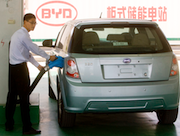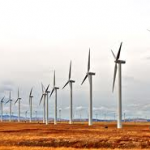 By John Addison (update 9/18/12; original 4/7/11)
By John Addison (update 9/18/12; original 4/7/11)
China leads the world with over 100 million riding e-scooters, e-bikes, and light-electric vehicles. By December 2015, China plans to have 500,000 electric vehicles that can travel slow streets to fast highways. Those EV will be supported with 220,000 charge points and 2,351 battery swap stations in the nation’s latest plans. China’s 12th Five Year Plan is summarized in a new Deutsche Bank (DB) report.
China will move to a more efficient lower carbon economy not only with electric cars and electric scooters. China is expanding electric transit and rail. For example, electric high-speed rail is targeted to expand by 29,000 miles between now and 2015. China high-speed rail is already more extensive than the mid-speed U.S. Acela system that supports daily riders in New York, Boston, Philadelphia, Washington DC and other Eastern cities.
Over the next five years, China will reduce its percentage of transportation that requires foreign oil for gasoline and diesel. China will also reduce the percentage of electricity generated by coal. By 2015, China will add:
- 70 GW wind
- 120 GW hydro
- 21 GW solar (increase from original plan of 5 GW)
- 40 GW nuclear
China plans to lead the world in using renewable energy. Although the Japanese nuclear disaster occurred as the 12th Plan was being drafted, China appears to be moving ahead with Generation IV nuclear which it views as safer than the Japanese plants built over 30 years ago. For example, Huaneng, China, is proceeding with the construction of a 200MW high-temperature gas-cooled reactor according to the DB report. More cost-effective natural gas plants, however, may yet be substituted for half of the planned nuclear expansion.
 China installed 25GW of new wind power in 2010, in comparison to only 5GW in the U.S. However, China’s wind installations grew faster than grid connection, creating a challenge for continued growth. China Wind Renewable Energy World Report
China installed 25GW of new wind power in 2010, in comparison to only 5GW in the U.S. However, China’s wind installations grew faster than grid connection, creating a challenge for continued growth. China Wind Renewable Energy World Report
$76.7 billion will be invested in new ultra high-voltage grid transmission to support the added capacity of new power according to the 12th Plan.
These investments will directly benefit China and support Chinese ambitions for Chinese global leadership in technology of the future. The 12th Plan identifies 7 Strategic Emerging Industries:
- Clean Energy Vehicles
- Energy Conservation and Environmental Projection
- New Energy
- New Materials
- Biotech
- High-end manufacturing equipment
- Next-gen IT
DB China Low Carbon Economy Strategy Summary:
Over the past year at DBCCA we have written about and commented upon emerging Chinese leadership in the climate and renewable energy world. This comes in the form of the policy momentum and ambition of China’s efforts to create a low carbon economy and improve its energy security through ambitious goals in terms of energy intensity targets and renewable energy deployment, backed up by strong incentives encouraging the development of green industries and jobs.
With China’s introduction of the 12th Five year Plan on March 5, 2011, we see the many new and expanded strong policy initiatives and green targets in the Plan as clear evidence that China’s low-carbon policies remain global best-in-class. According to Hu Angang of the Chinese Academy of Sciences, 33.3% of the targets in the 12th Five Year Plan address resource or environmental objectives compared to 27.2% in the prior 11th Five Year Plan. This is borne out in the summary Draft 12th Five Year Plan which contains a new section on “…energy conservation and environmental protection in responding to climate change” and lays out significant progress in key areas, describing the high-level objectives of China’s National Climate Change Program. It is also stated that pilot cap-and-trade systems for carbon and other criteria pollutants will be undertaken. This global leadership in particular contrasts to the stalled efforts at the US Federal level. Gone are the days when commentators expected US carbon policy to lead the way for China to join a decarbonizing world. Rather, it is now China who is preparing for carbon markets by 2013 and, as the world’s largest manufacturing economy, it is stepping up to join the carbon markets in Europe.
The Draft Plan establishes goals for 2015, in addition to many of the 2020 targets already announced. China has targeted that energy intensity by 2015 will improve by 18% from 2010 and non fossil fuel energy will increase to 11.4% of total generation. A total of 235 GW of renewable and low carbon energy generation capacity are also announced, with new 2015 goals including wind capacity increasing by at least 70GW (from 42 GW currently) and solar capacity increasing to 5GW (from 625 MW currently). Importantly transmission lines for renewable are also targeted for expansion as part of State Grid of China’s announced plans to invest RMB 500 billion (US$76.7 billion) over the next five years.
Following the announcement of the Plan, events in Japan brought issues of nuclear safety again into sharp focus. In our estimation, China remains committed to low-carbon nuclear energy development as a necessary element of a national decarbonizing strategy. Despite the Fukushima event, we do not expect China to cancel any nuclear plants, although timetables for development may be disrupted as the experts evaluate safety upgrades and the feasibility of rapid migration to newer and safer nuclear designs. Signs of such a migration are occurring with announcement on March 24, 2011 that Huaneng Nuclear Power Development Corporation (“Huaneng”) will commence construction next month of a 200MW Generation IV gas-cooled reactor in Shandong province. We believe that China will continue to look for the safest nuclear options. The prospect of a gap in low-carbon energy plans arising from what could be multi-year delays for an estimated 24 GW of planned nuclear capacity should, we believe, give a strong boost to cleaner energy sources such as renewable solar and wind, along with more gas for base load reasons. Further, we believe continued turmoil in the oil-producing regions of the world serves as further impetus for China to speed development of renewable resources as a means to reduce the China’s strategic energy supply risk while nuclear safety and new reactor designs are reviewed.
In our estimation, the 12th Five year Plan create a broad range of climate change-related investment opportunities for: (1) equipment and services companies in the wind, solar power and hydro sectors; (2) equipment and technology companies in the low-carbon transportation sector and; (3) project finance activity in the several areas of renewable power farm development. The Fukushima situation and Middle East unrest, we believe, further amplify these trends.
We believe the continued trend toward higher energy efficiency also creates investment opportunities in the hardware, software and services areas since energy services and energy management businesses have received clear support in the 12th Five Year Plan. Shifts away from carbon-intensive electricity to both low carbon nuclear and cleaner natural gas generation are, in our opinion, likely to be fertile areas for investment as well.
Disclosure: author owns stock in Goldwind and Zhuzhou CSR Times Electric.
